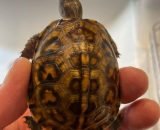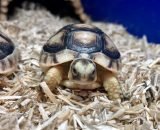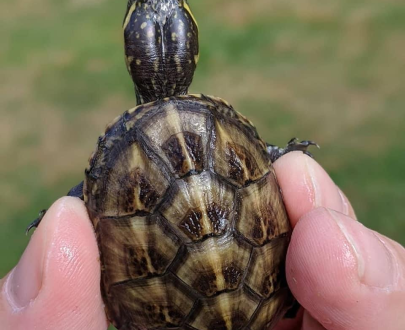- You have no items in your shopping cart
- Subtotal: $0.00
A vibrant and energetic aquatic pet, the Peacock Slider Turtle, sometimes called the Peacock River Turtle, may make a wonderful addition to any home. Here is all the information you require about this amazing turtle.
The Peacock Slider Turtle is distinguished by its remarkable look. Its head, neck, and legs are covered in vivid, iridescent green markings, which contrast with its smooth, dark shell. Typically, it has greenish-brown skin with yellow streaks. The male Peacock Slider Turtle has thicker tail and longer claws than the female.
The Peacock Slider’s behaviour Turtles make lively, inquisitive pets. Swimming, sunbathing, and exploring their environment are things they like to do. Because they are social beings, they can develop strong bonds with their owners.
Habitat: Peacock Slider Turtles need a sizable aquarium or outdoor pond with a filtration system and a basking space if they’re to be kept as pets. Additionally, they require UVB lighting to properly metabolise calcium and preserve their shells. The ideal temperature for the water should be between 75 and 80 degrees Fahrenheit, while the ideal temperature for the sunbathing area should be around 85 degrees.
Peacock Slider as a meal As omnivores, turtles will consume a variety of foods. Commercial turtle pellets, fresh produce, and occasionally treats like live or frozen insects, prawns, and fish should make up a healthy diet for them.
Care:
Slider Peacock For turtles to survive, their underwater environment must be kept pristine. The aquarium or pond should feature a basking area where the turtle may relax and absorb UVB rays, and it should be big enough to allow for swimming and diving. The ideal temperature for the water should be between 75 and 80 degrees Fahrenheit, while the ideal temperature for the sunbathing area should be around 85 degrees. To keep the water in the habitat clean and suitable for the turtle, the habitat should also feature a filtration system.
Slider Peacock Due to their omnivorous nature, turtles need a diet that includes commercial turtle pellets, fresh produce, and occasionally, treats like live or frozen insects, prawns, and fish. To make sure they are getting all the nutrients they require, it is crucial to serve them a range of meals. They should also always have access to fresh water, and the water should be changed frequently.
Finally, Peacock Slider Turtles should visit a vet who specialises in reptiles on a regular basis for examinations. This can assure their wellbeing and enable early detection of any potential health problems.
Benefits:
A variety of advantages can be had by owners of peacock slider turtles. They can offer company and entertainment because they are social and sociable animals. They are also rather low-maintenance animals, which makes them a suitable option for people who don’t have the time or money to care for other, more demanding animals.
Peacock Slider Turtles make excellent pets for amusement and friendship, as well as for education. They can assist in educating both adults and children about the value of proper pet ownership as well as the particular requirements of aquatic reptiles.
A sense of relaxation and stress alleviation can also be obtained from peacock slider turtles. It can be soothing and pleasant to watch them swim and bask in their natural environment. Those who experience worry or stress in particular may find this to be helpful.
Another interesting and attractive pet is the peacock slider turtle. They stand out as a unique addition to any home or collection because of their vivid markings and unique personalities. They are frequently sought after by enthusiasts and collectors, and their acceptance as pets is rising.
Finally, having a Peacock Slider Turtle as a pet can be gratifying and joyful. These turtles can live for several decades if given the right care and attention, making them a dependable source of amusement and friendship. They may also be handed down from one generation to the next, peacock turtles for sale where they will remain a beloved family pet for many years.
Overall, the Peacock Slider Turtle is a fascinating and eye-catching aquatic pet that, with the right care, may offer years of friendship, entertainment, and educational value. They make excellent choices for anybody searching for an interesting and energetic pet to add to their home because they are generally low-maintenance animals.
In conclusion, Peacock Slider Turtles are an interesting and distinctive aquatic pet that can offer a variety of advantages to its owners. These turtles are an excellent option for anyone looking for a low-maintenance pet with lots of personality, offering companionship, entertainment, educational value, and environmental balance. A Peacock Slider Turtle may make a long-lasting and rewarding addition to any home or collection with the right care and attention.
Is it advisable to dry off a turtle completely after being in the water?
It is not advisable to completely dry off a turtle after it has been in the water. This can be stressful for aquatic species, especially young turtles, as they are naturally meant to hide in the water plants and blend in with their environment. Therefore, allowing the turtle to air dry naturally without any intervention is recommended to help them feel more comfortable and reduce stress.
What are some considerations for setting up a new turtle enclosure in a limited space?
When setting up a new turtle enclosure in a limited space, several key considerations should be kept in mind to ensure the well-being of your pet. First and foremost, it is essential to assess the available space to determine the feasibility of providing adequate living conditions for the turtle. In a limited area, it may be necessary to make adjustments such as regular water changes if there isn’t enough room for a filter.
Additionally, optimizing the layout of the enclosure by incorporating elements like fake plants and a suitable basking area is crucial. Turtles often enjoy basking under a heat source, and providing a safe and comfortable spot for this activity is vital for their overall health. It’s also important to consider the turtle’s natural behavior, such as spending time in the water, and ensuring that the water is clean and warm to support their well-being.
Furthermore, monitoring the turtle’s eating habits and preferences is essential in a limited space enclosure. Offering a varied diet, including vegetables and appropriate live or packaged food options, is crucial for their nutrition and growth. Regular weighing of the turtle can help track their health status and ensure they are receiving adequate nourishment.
Lastly, creating a stress-free environment is paramount for the well-being of the turtle, especially in limited space setups. Avoid unnecessary handling or disruptions that may cause distress to the turtle and follow expert advice on turtle care to maintain a healthy and happy pet.
How can I keep track of the turtle’s activities and well-being in the enclosure, especially if I have visual impairments?
To provide proper care for your turtle and monitor its activities in the enclosure, especially if you have visual impairments, you can use a variety of methods. One effective way is to document your turtle’s well-being by posting detailed updates and photos on online forums or platforms dedicated to reptile care. By creating threads specifically for your turtle, you can keep track of its growth, behavior, and any adjustments you make to its habitat. Utilizing the search feature on these platforms, you can easily retrieve past threads related to your turtle, allowing you to review previous discussions and observe the changes in your turtle’s environment over time. Additionally, by connecting with other reptile enthusiasts within these communities, you can seek advice, share experiences, and stay informed about best practices for caring for your visually impaired turtle effectively.
How can I supplement the diet of my baby turtle for optimal health?
Supplementing the diet of your baby turtle for optimal health is crucial for their growth and well-being. Providing a balanced and varied diet is key to ensuring they receive all the necessary nutrients. It is recommended to start your baby turtle on high-quality commercial pellets as a primary source of nutrition. Look for reputable brands like Hikari Sinking Carnivore Pellets, which are often recommended by experts for their nutritional value. In addition to pellets, offering live food options can be beneficial for some baby turtles. Earthworms are a nutritious and natural choice that many turtles enjoy. Watching your hatchling engage with live prey can be both entertaining and rewarding. By providing a mix of commercial pellets and live food options, you can offer a well-rounded diet that mimics what turtles would consume in the wild. It’s important to observe your baby turtle’s preferences and adjust their diet accordingly. Some turtles may prefer only pellets, while others may enjoy a mix of both pellets and live food. By monitoring their behavior and dietary intake, you can ensure they are receiving the nutrition they need for optimal health and growth. Remember to also provide a sandy substrate in their tank, as many turtles enjoy digging and burrowing. Creating a comfortable and enriching environment will contribute to your baby turtle’s overall well-being. By following these dietary and habitat recommendations, you can help your baby turtle thrive and grow into a healthy adult.
What are some tips for feeding baby turtles and triggering their hunting instincts?
Feeding and triggering the hunting instincts of baby turtles require special care and attention. Here are some tips to help you ensure the well-being and development of your young turtle:
1. **Avoid Over-Handling**: It’s crucial not to over-handle hatchlings as it can be very stressful for them. This is particularly important for turtles that have already experienced travel and handling excessively before reaching you.
2. **Provide Adequate Habitat**: Create a suitable environment for your baby turtle by offering areas for hiding and climbing. Too much open space can be intimidating for a prey species like a baby turtle. Consider adding plastic vines to allow them to hide and explore safely.
3. **Offer Live Prey**: Baby turtles typically require meat for their diet, and live, moving prey can help trigger their hunting and feeding instincts. Look for live bloodworms, small red wiggler earthworms, or pinhead crickets to entice them to feed. Be prepared for messiness, as turtles can be messy eaters. To avoid disrupting their feeding response, consider using baby monitors to observe them discreetly.
4. **Supplement with Calorie-Rich Soaks**: You can provide additional nutrients through calorie-supplementing soaks using products like carrot baby food mixed with water. However, be cautious about placing the turtle directly under a heat bulb to avoid overheating. Instead, position the container with the soak to the side of the heat source. Alternatively, a shallow soak with warm water and a drop of nutrical or kitten calorie supplement can be effective, especially for very tiny turtles. Consider using this method until the turtle starts feeding regularly.
By following these tips, you can help ensure that your baby turtle receives the appropriate nutrition and stimulation to promote healthy growth and development. Remember to monitor their progress closely and seek advice if needed from experienced individuals in turtle care.
How can I avoid stressing out my baby turtle through handling and ensure it feels safe in its habitat?
To ensure your baby turtle feels safe in its habitat and to minimize stress during handling, it is important to avoid over-handling hatchlings as it can be very stressful for them. Providing spaces for the turtle to hide, such as plastic vines, can help create a more secure environment. Baby turtles, being prey species, can feel vulnerable in habitats with too much open space. By incorporating hiding spots and structures for climbing, you can help the baby turtle feel more secure and comfortable in its surroundings. Regularly observing the turtle’s behavior and making adjustments to the habitat as needed can also contribute to a stress-free environment for your pet.
What suggestions did ZenHerper provide to help with the peacock slider hatchling’s feeding habits and habitat setup?
ZenHerper offered several helpful suggestions for improving the feeding habits and habitat setup of the peacock slider hatchling. Firstly, it was advised not to over-handle hatchlings as this can be stressful for them. To create a more comforting habitat, ZenHerper recommended adding plastic vines to provide the hatchling with hiding spots and opportunities to climb in the water. Regarding feeding habits, it was emphasized that hatchlings require meat rather than vegetation. Live, moving prey such as bloodworms, red wiggler earthworms, or pinhead crickets were suggested as suitable options. Additionally, a mix of carrot baby food with water was recommended as a calorie-supplementing soak to aid in the hatchling’s nutrition. Placing this container away from the heat source was also suggested. Lastly, ZenHerper proposed providing a very shallow soak with warm water and a drop of nutrical/kitten calorie supplement dissolved in it, to be used daily until the hatchling starts feeding. These suggestions were aimed at improving both the nutritional intake and environmental comfort of the peacock slider hatchling.
What steps has Dysania taken to try and encourage the peacock slider hatchling to eat?
To encourage the peacock slider hatchling to eat, Dysania has tried various methods. Dysania mentions that despite having the hatchling for a week without any signs of eating, she has attempted feeding once a day. Additionally, she has tried increasing the feeding frequency to twice a day, but the hatchling only stays at the feeding area briefly. Dysania is considering soaking the hatchling in vegetables for nutrients and warmth, as well as placing the hatchling in a tub with paper towels under the basking area for drying out daily until it begins to eat and attempts to climb onto the basking area independently.
What are some of the issues Dysania is facing with the peacock slider hatchling not eating?
Dysania is experiencing challenges with her peacock slider hatchling not eating. Some potential issues could be related to the hatchling’s environment and diet. Despite providing a suitable water temperature, a uva/uvb combination bulb for basking, a calcium slow-release tab, and a varied selection of food including hatchling food, butter lettuce, blood worms, and cucumber bits, the hatchling is still not consuming food adequately. Dysania has also observed that the hatchling only spends a short time on the basking area. Factors such as stress, improper temperature regulation, inadequate nutrition, or health issues might be contributing to the hatchling’s reluctance to eat. Dysania’s efforts to create a comfortable and nourishing environment for the hatchling illustrate her concern and dedication to addressing the feeding issue.
Where did Dysania purchase the peacock slider hatchling from?
Dysania acquired the peacock slider hatchling from an online store called Floridareptiles.us
How did Dysania improve the living conditions for the previous turtle she cared for?
Dysania enhanced the living conditions for the previous turtle she cared for by upgrading to a larger tank that included a basking area and deeper water. She meticulously set up essential equipment such as a basking lamp, floating dock, and water heater to ensure a comfortable environment for the turtle. In addition, Dysania introduced different types of food, like ghost shrimp, to provide enriching variety to the turtle’s diet. Through these thoughtful arrangements, the turtle could now engage in natural behaviors like basking, swimming, and feeding properly under Dysania‘s attentive care.








Customer reviews
Reviews
There are no reviews yet.
Write a customer review